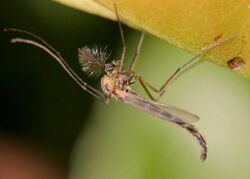Biology:Chironomus
| Chironomus | |
|---|---|

| |
| Chironomus plumosus adult male | |
| Scientific classification | |
| Domain: | Eukaryota |
| Kingdom: | Animalia |
| Phylum: | Arthropoda |
| Class: | Insecta |
| Order: | Diptera |
| Family: | Chironomidae |
| Tribe: | Chironomini |
| Genus: | Chironomus Meigen, 1803 |
| Diversity | |
| at least 640 species | |
Chironomus is a genus of nonbiting midges in the subfamily Chironominae of the bloodworm family, Chironomidae, containing several cryptic species that can only be distinguished by experts based on the characteristics of their giant chromosomes.
In the early 20th century the name Tendipes Meigen, 1800 was often used instead.[1] In 1963 the International Commission on Zoological Nomenclature restored the traditional name Chironomus.
Description
Adult Chironomus are midges with the pronotum widest in the middle and bearing a notch, the head usually bearing a pair of small tubercles above the antennal bases, the antennal flagellum of males having 11 segments, and the male genitalia has inferior volsella large and larger than superior volsella. They range from 5 to 13 mm in length. Larvae are red and usually have tubes on the side or bottom of the eighth abdominal segment. These features are not unique to Chironomus, also being found in some related genera.[2]
Adult males can be distinguished from females by their feather-like antennae.[3]
Behaviour
When at rest, adults often raise their front legs and vibrate them. This is the source of the genus name, which is derived from "cheironomos" (Greek for "one who moves the hands").[2]
Habitat
Larvae of Chironomus usually live in aquatic sediment. Those of the C. decorus group, C. riparius group and C. stigmaterus generally live in conditions of high nutrients and low oxygen. There are also Chironomus that live in relatively clean water.[2]
The larvae of several species inhabit the profundal zone where they can reach relatively high densities. They use a combination of hemoglobin-like proteins and undulatory movements in their burrows to obtain oxygen in poorly oxygenated habitats.[4]
See also
Gallery
References
- ↑ Townes, H. K. (1945). "The nearctic species of Tendipedini (Diptera, Tendipedidae (= Chironomidae))". American Midland Naturalist 34 (1): 1–206. doi:10.2307/2421112.
- ↑ 2.0 2.1 2.2 "Genus Chironomus". https://bugguide.net/node/view/83349.
- ↑ Will, Kip; Gross, Joyce; Rubinoff, Daniel; Powell, Jerry A. (2020). Field Guide to California Insects. Oakland, California: University of California Press. pp. 285. ISBN 9780520288744.
- ↑ Int Panis, L; Goddeeris, B; Verheyen, R F (1995). "On the relationship between vertical microdistribution and adaptations to oxygen stress in littoral Chironomidae (Diptera)". Hydrobiologia 318 (1): 61–67. doi:10.1007/BF00014132. https://www.researchgate.net/publication/227217922.
Wikidata ☰ Q2704714 entry
 |





